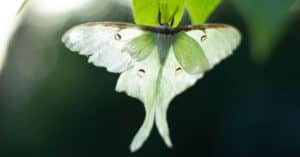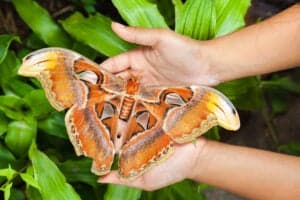There are more than 160,000 species of moths in the world. Luckily, there are only a few types of moths that are black and white. If you’ve recently spotted a black and white moth and want to learn what species it is, keep reading.
Moths are viewed as pests in many countries because of their destructive nature. The insects have a reputation for eating clothing and other fibers. The truth is, most species of moths drink nectar to sustain themselves. They probably aren’t interested in your brand-new outfit at all.
Still, the fuzzy creatures can cause destruction for farmers and gardeners. Adult moths are not a problem, but their larvae can be. Gypsy moth larvae destroy trees, and cabbage moth larvae eat through broccoli plants and other leafy vegetables. Tomato hornworms (the larvae of the five-spotted hawk moth) are named after their taste for tomato plants.
However, moths are not just pesky insects that are trying to ruin your garden and home. They are excellent pollinators, doing their best work after dark when most other pollinators are inactive. In fact, one study showed that nocturnal moths pollinate more species of flowers than daytime bees do. Moths are also an essential part of the food chain, consumed by bats and songbirds, as well as some mammals. Here’s a list of all the moths that are black and white.
American Ermine
Location: North America (U.S. and Canada)
Don’t let the name fool you — the American ermine moth is found in both Canada and America. If the moth you spotted looked like it had black polka dots on a white body, chances are this is it. While many species have dots, these moths have more than most. The spots are usually in three or four lines that go down their backs vertically. American ermine moths have a wingspan of around ¾ to 1 inch.

American ermine moths have black polka dots on a white body.
©Barry and Carole Bowden/Shutterstock.com
Fall Webworm
Location: North America
Some fall webworm moths are completely white, but most have a few specks of black on their back wings. One interesting fact about this species is that they usually have more black spots if they live further south, and fewer if they live north. They have a wingspan of 1 to 1¼ inches. The moths are often found around deciduous trees — their main food source.
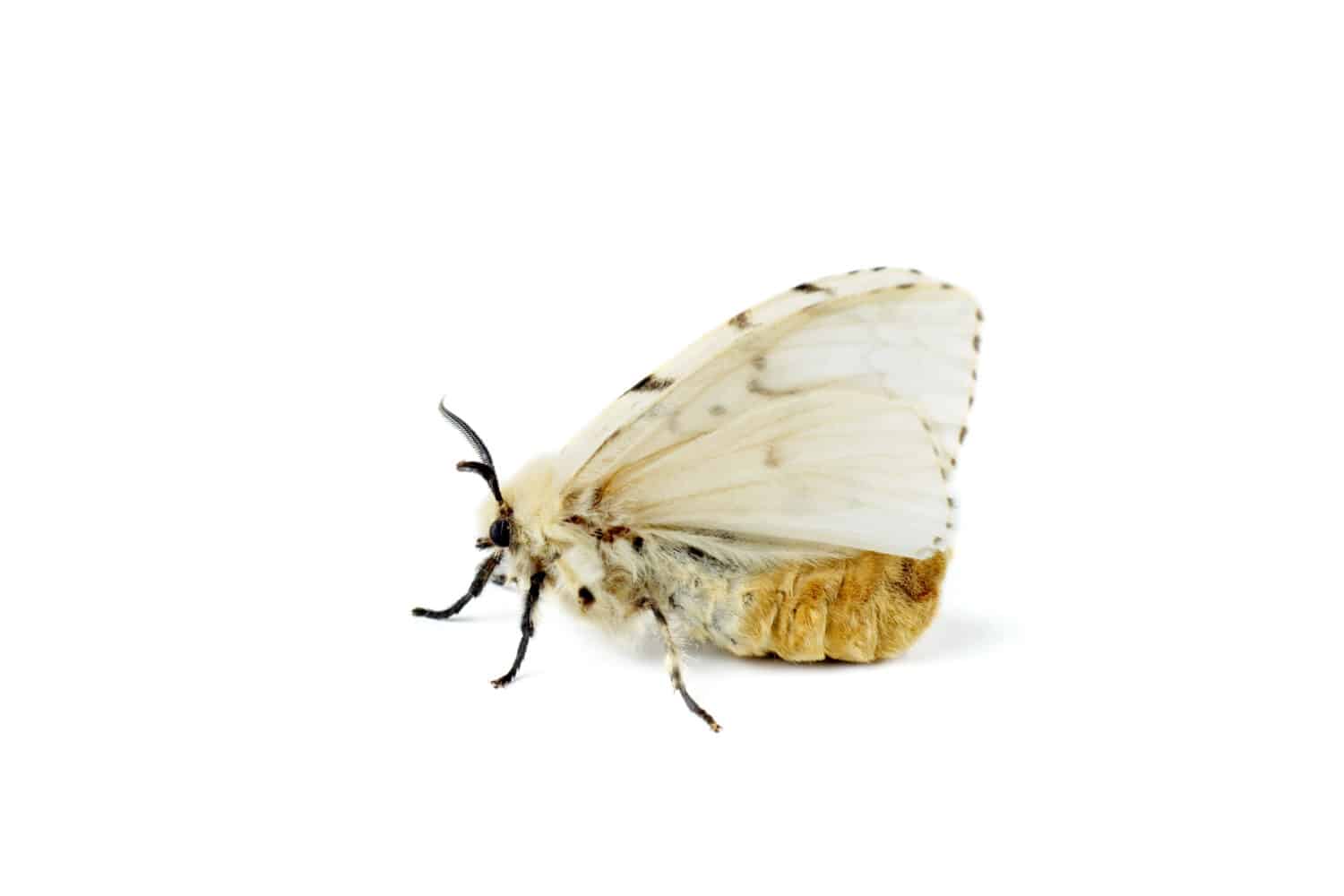
Some fall webworm moths are completely white, but most have a few specks of black on their back wings.
©Ivaschenko Roman/Shutterstock.com
Giant Leopard
Location: North America
Giant leopard moths can live as far south as Colombia and as far north as Ontario, CA. They are very artistic-looking creatures, with crisp black rings lining their bright white bodies. Some of the rings are hollow, and others are solid. They vary in size, with males reaching a wingspan of around 3½ inches, and females at 2¼ inches. These moths are nocturnal, and if found may play dead as a defense mechanism.

Giant
leopard
moths are as large as a human palm, with a wingspan of over three inches, and the males are almost twice as large as the females.
©Andy Reago & Chrissy McClarren (Wildreturn) / CC BY 2.0, Flickr – License
Eight-Spotted Forester
Location: North America (U.S.)
Eight-spotted forester moths are mainly found in the eastern United States and a few parts of Canada including Quebec. They have black bodies and wings with large white spots. They are diurnal and can be found drinking nectar as their main food source. These moths have a wingspan of 1 to 1½ inches.

Eight-spotted forester moths have black bodies and wings with large white spots.
©Paul Reeves Photography/Shutterstock.com
White Furcula
Location: North America
The white furcula moth is found throughout most of North America and is white and black or gray in color. They have a zig-zag pattern that goes down their backs. They may also have a bit of red on their wings. The moths have a wingspan of 1¼ to 1½ inches.
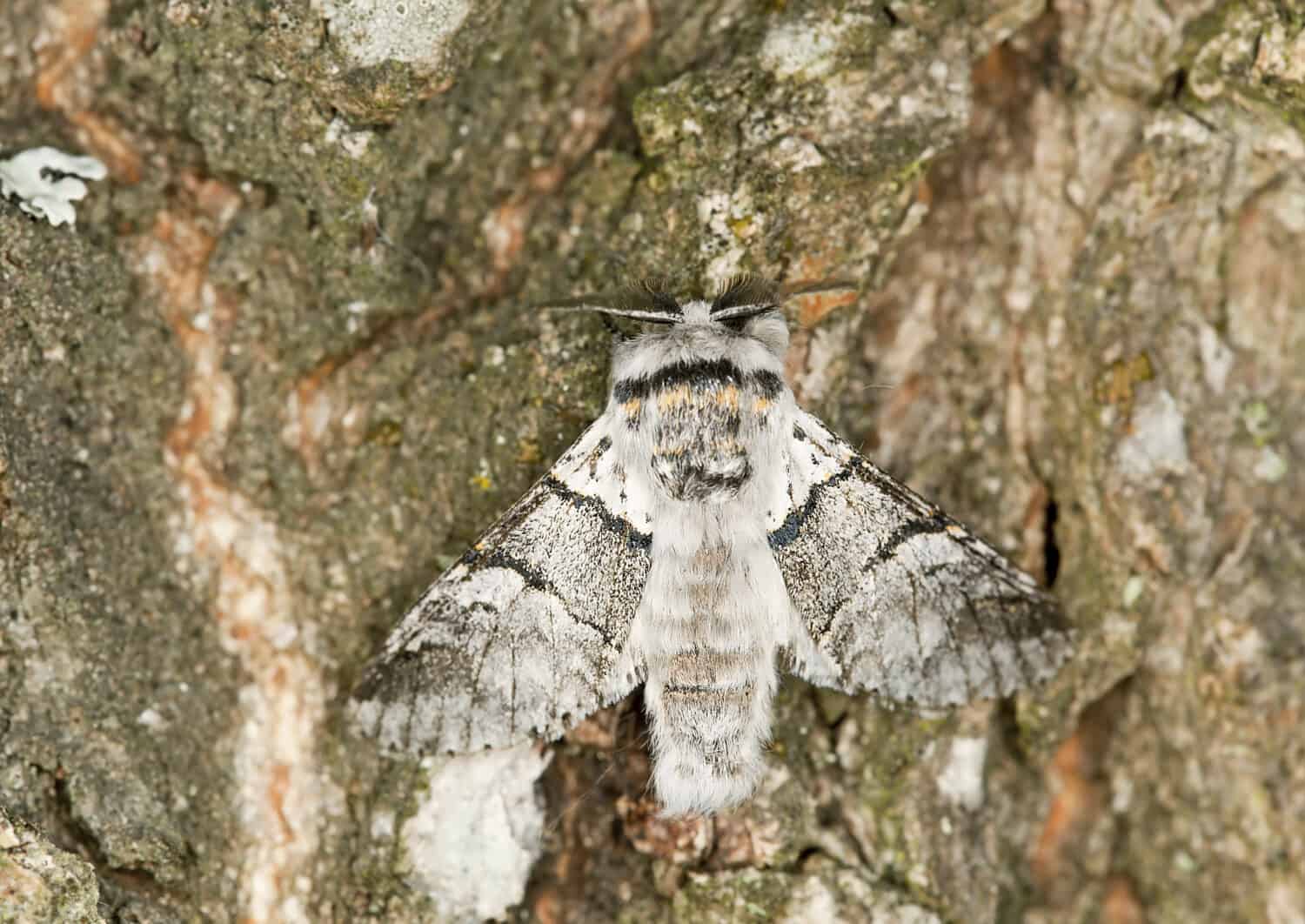
White furcula moths are white and black or gray in color. They have a zig-zag pattern that goes down their backs.
©Henrik Larsson/Shutterstock.com
Salt Marsh
Location: North America (U.S.)
The salt marsh moth species is mainly found in Texas and Florida. They are mainly white in color with black speckles that go down their backs. These speckles are irregular and can be any shape or size, but are usually small. They have a wingspan of around 2 ½ inches.
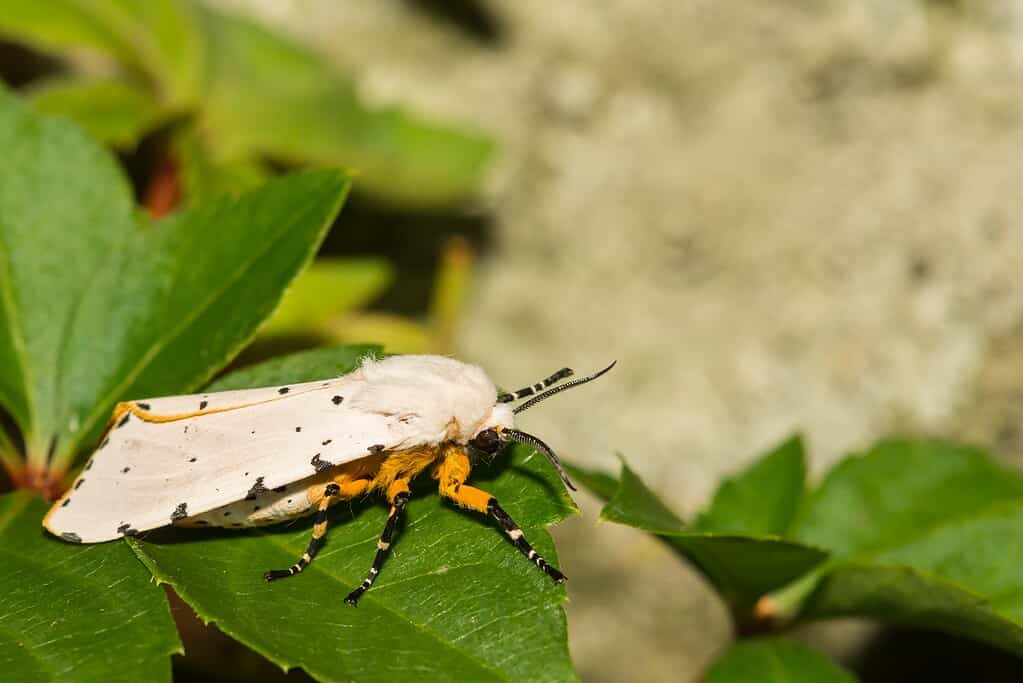
Salt marsh moths are mainly white in color with black speckles that go down their backs.
©Jay Ondreicka/Shutterstock.com
Clymene Moth
Location: Eastern North America
The Clymene moth species have a white or cream base color with a unique pattern of black that goes down the middle of their bodies and on the outsides of their wings. They have a yellow-orange hindwing that shows when they spread their wings. The moths have a wingspan of 1½ to 2 inches.
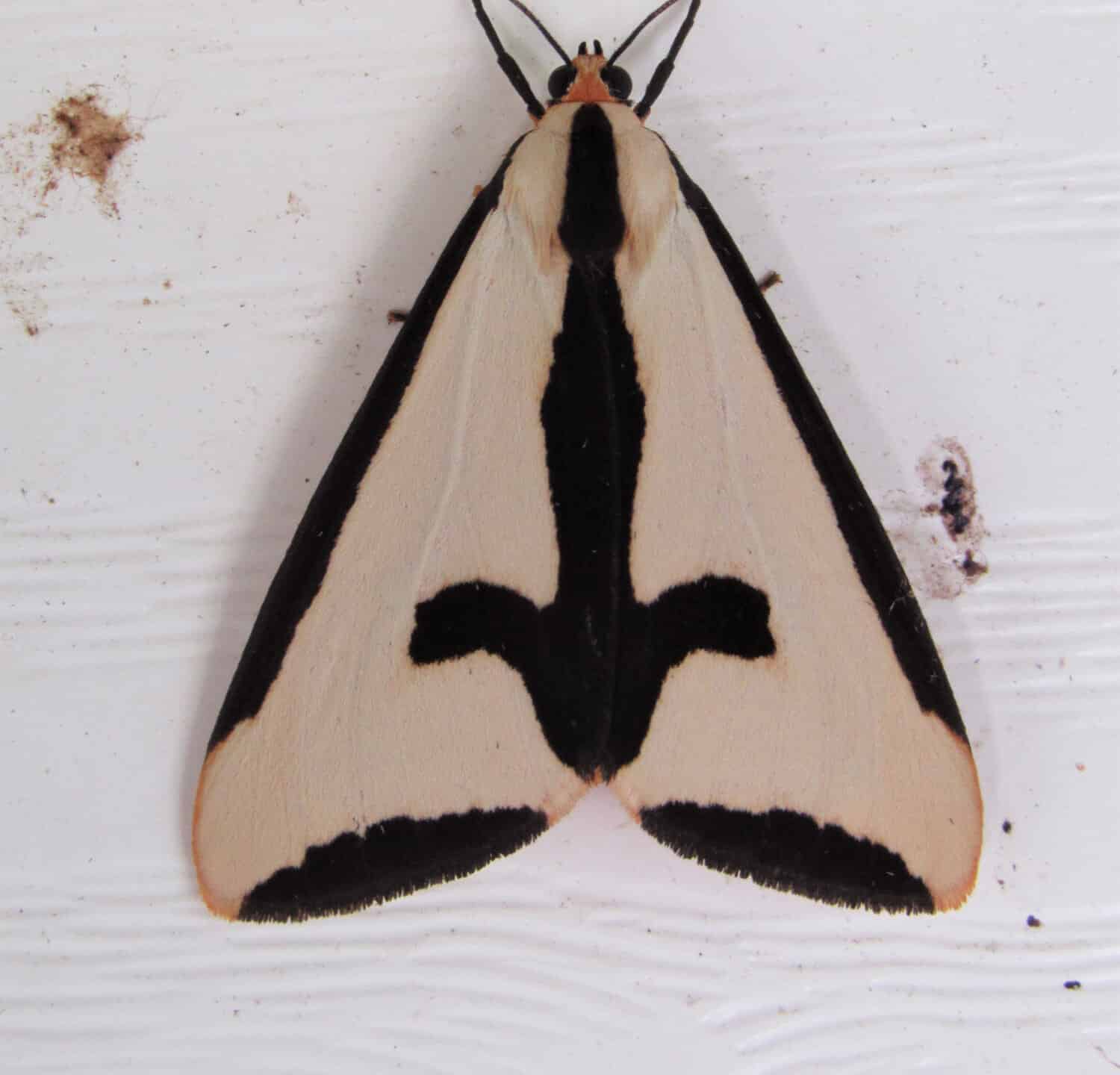
The Clymene moth species have a white or cream base color with a unique pattern of black that goes down the middle of their bodies and on the outsides of their wings.
©Isabel Eve/Shutterstock.com
Rustic Sphinx
Location: North America (U.S. and Mexico)
The rustic sphinx moths are nocturnal pollinators that are often mistaken for hummingbirds. They have a symmetrical pattern of white, gray, and black squiggly lines that run across their entire bodies and wings. They are day and nighttime pollinators with a wingspan of 3½ to 6 inches.
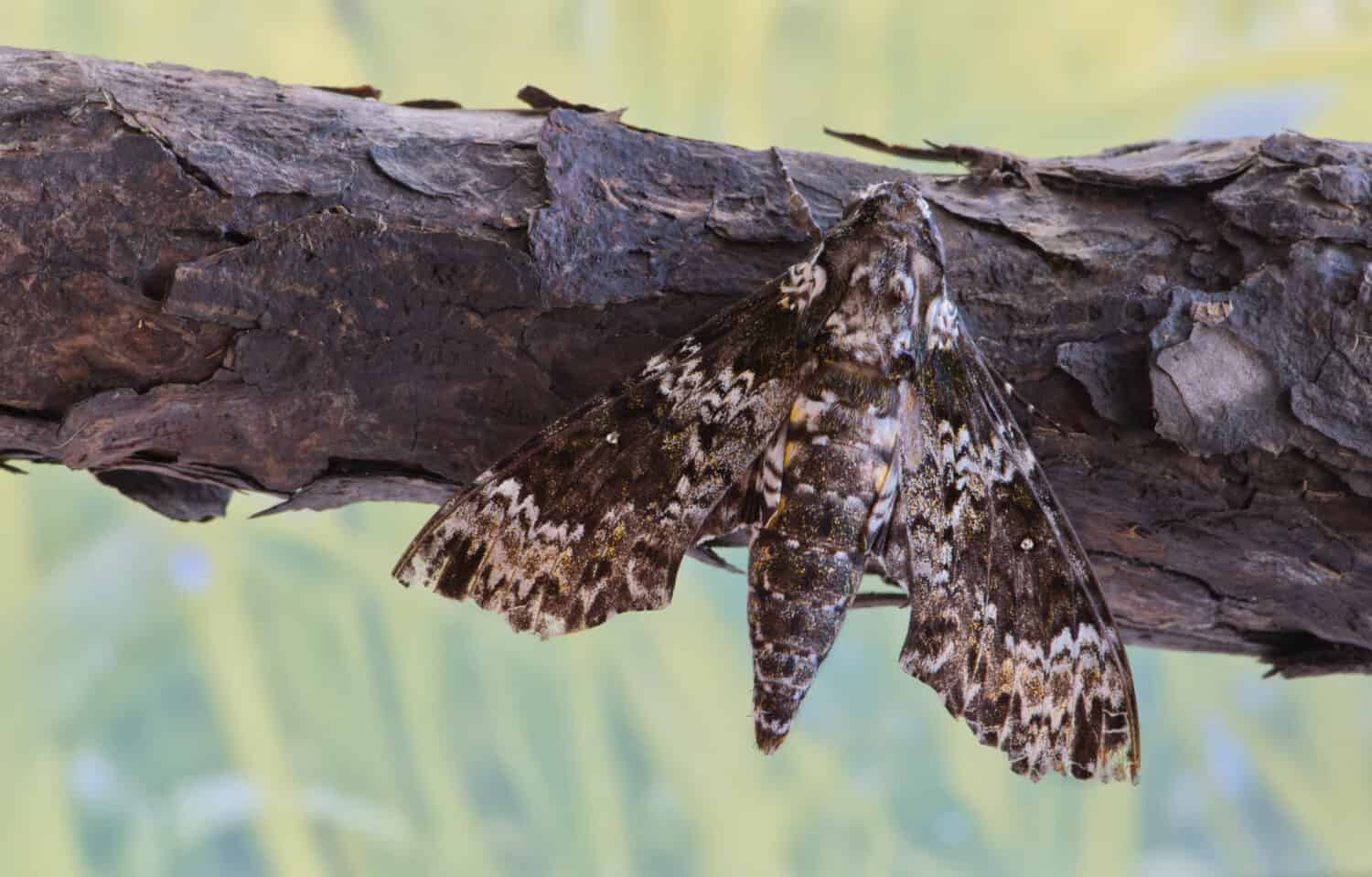
The wingspan of the rustic sphinx can reach up to six inches.
©Brett Hondow/Shutterstock.com
White Underwing
Location: North America (Northern U.S. and Canada)
The white underwing moths are white with black or gray wavy lines that go symmetrically down their bodies. Their hindwings usually have a different pattern of black and white than their forewings, but can only be seen during flight. They are small moths with an average wingspan of a little over ¼ inch.
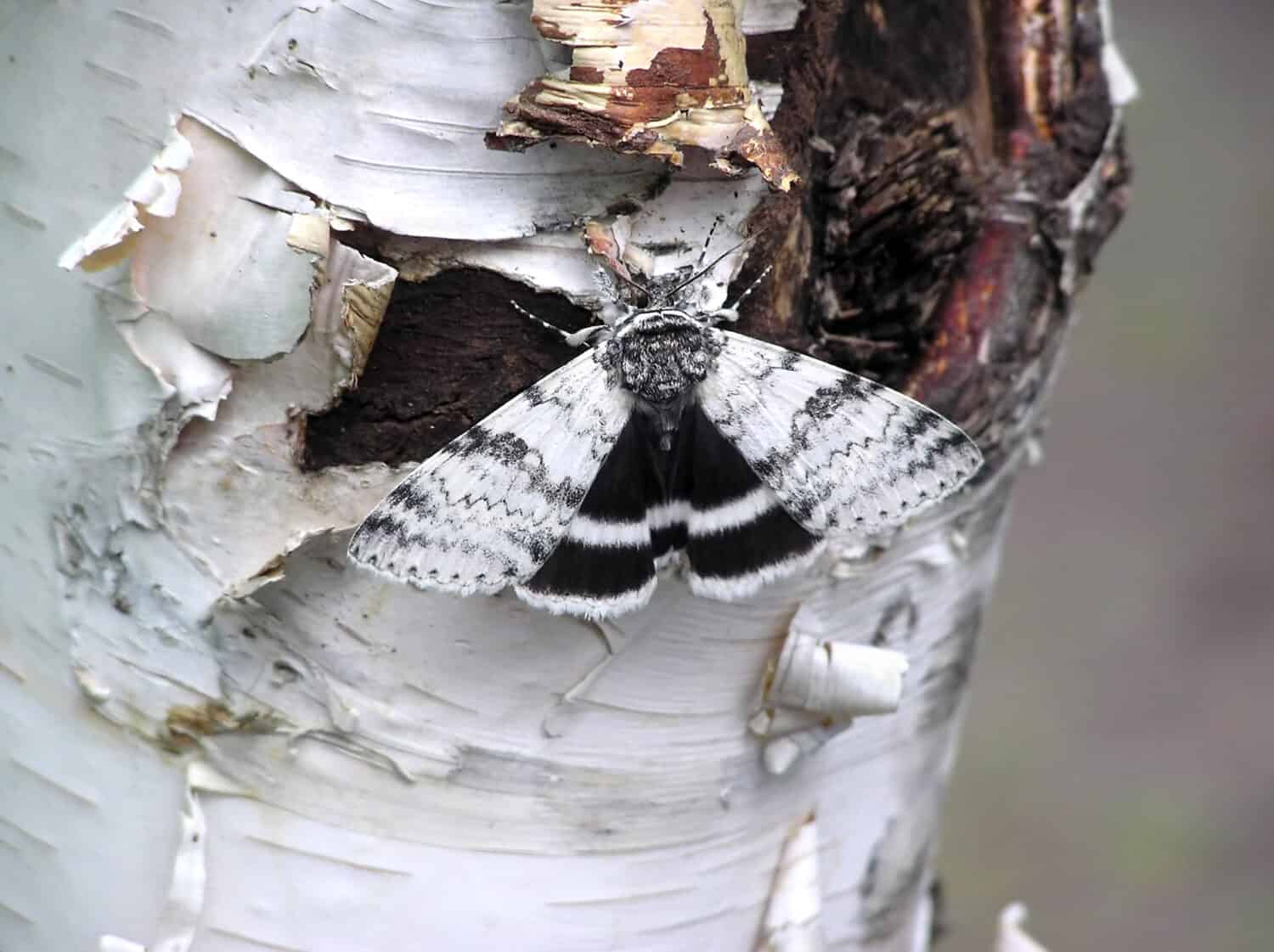
White underwing moth using its camouflage to blend into the tree bark.
©Sylvie Bouchard/Shutterstock.com
Arge Moth
Location: North America (Mainly U.S.)
The arge moth species is white with symmetrical black triangles and lines going down their bodies. They have a wingspan of 1½ to 2 inches.
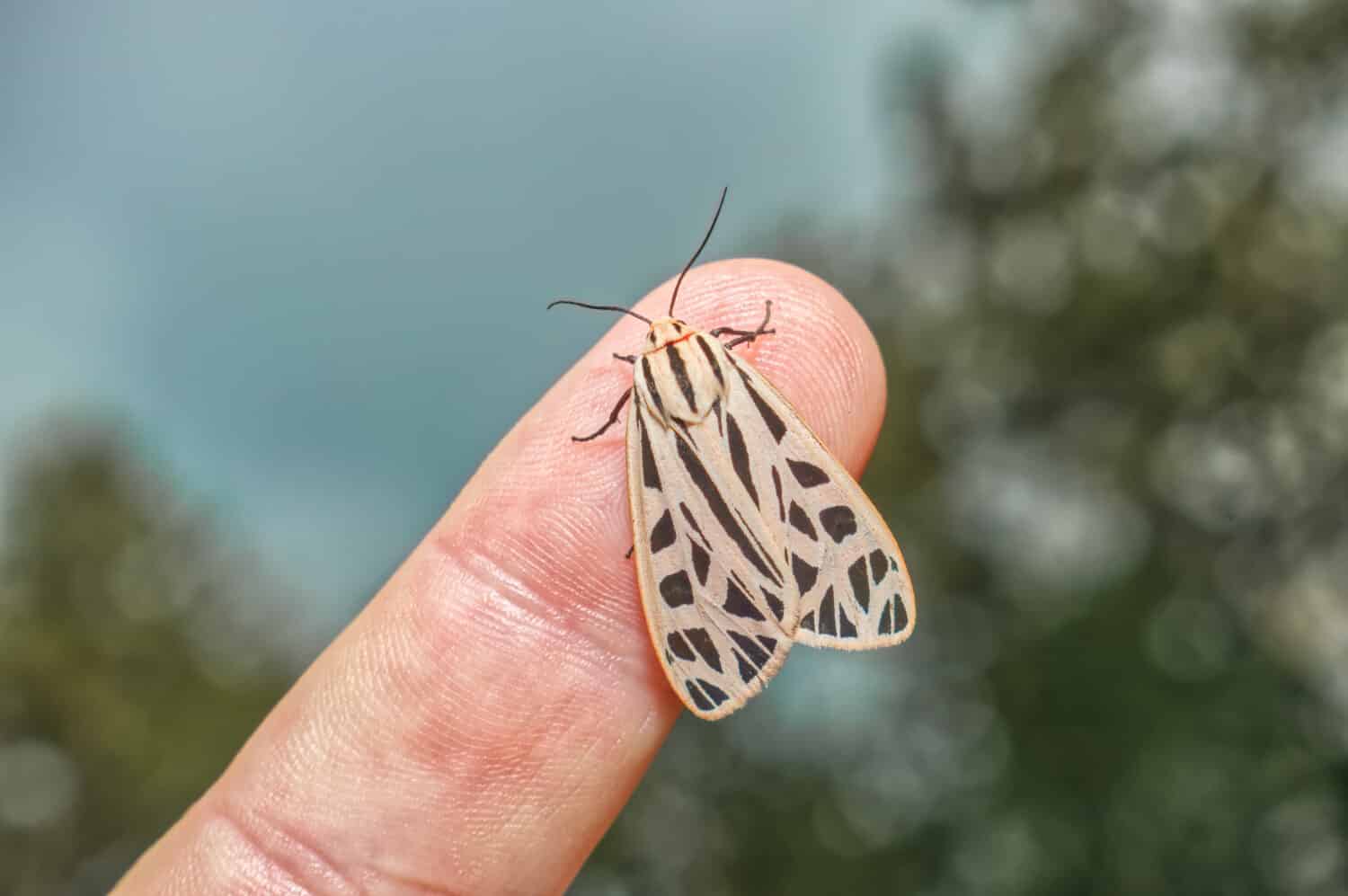
Arge moths have unique geometric patterns on their bodies.
©Chase D’animulls/Shutterstock.com
Redbud Leaffolder
Location: North America (Southeast U.S.)
The redbud leaffolder moth species are black or dark brown with large white spots. They get their name from their ability to seal leaves together with silk, providing a home and meal for their larvae. Adult redbud leaffolders have a wingspan of around half an inch.
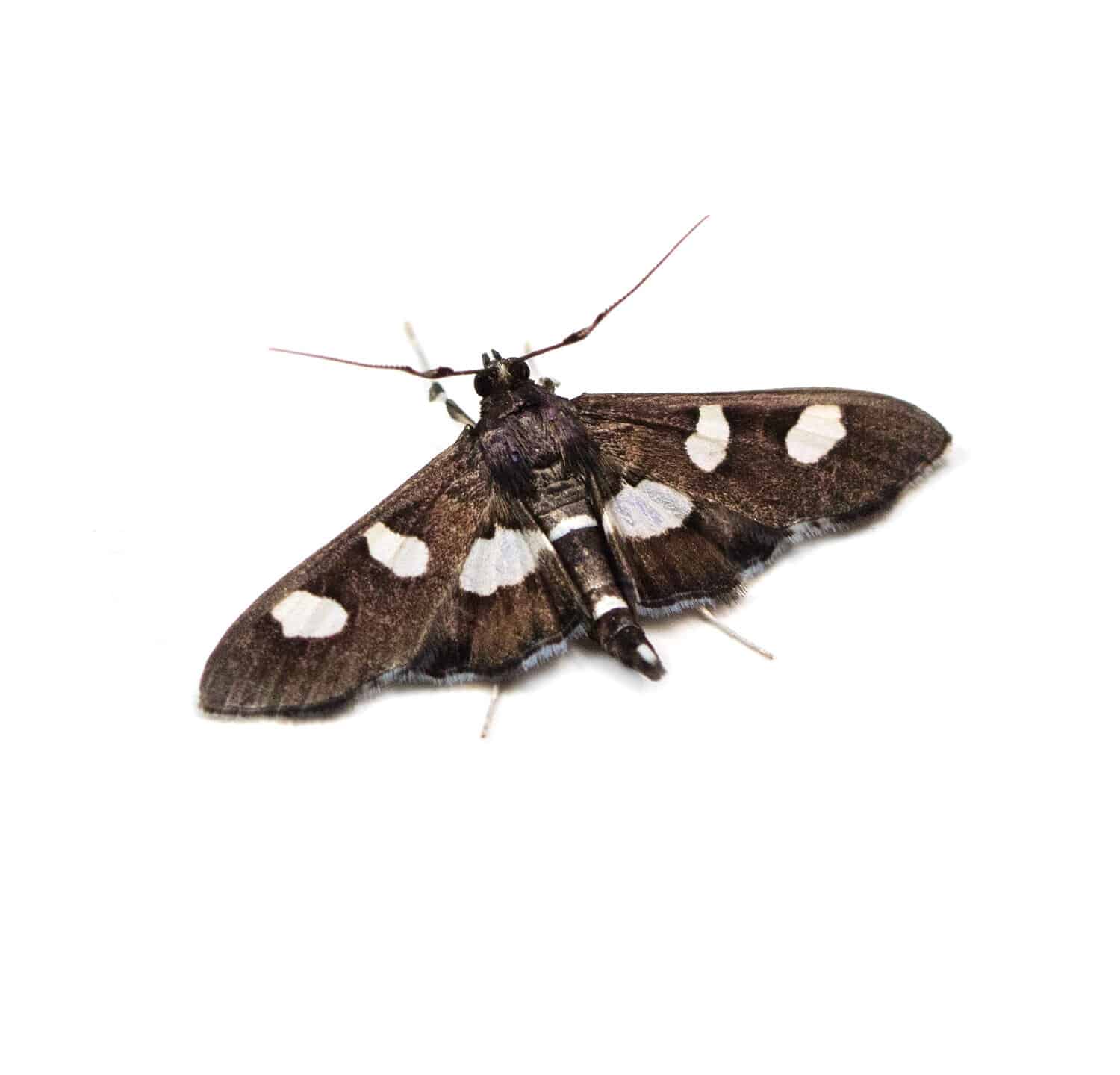
Redbud leaffolder moths are dark brown or black with large white spots.
©Melinda Fawver/Shutterstock.com
Harris’ Three Spot
Location: North America (U.S. and Canada)
The Harris’ three spot moths are white with black wavy lines across their whole body. They also have a few brown spots on their wings and back. Their hindwings are almost all white and only show during flight or when spread. They have a wingspan of around 1¼ inches.
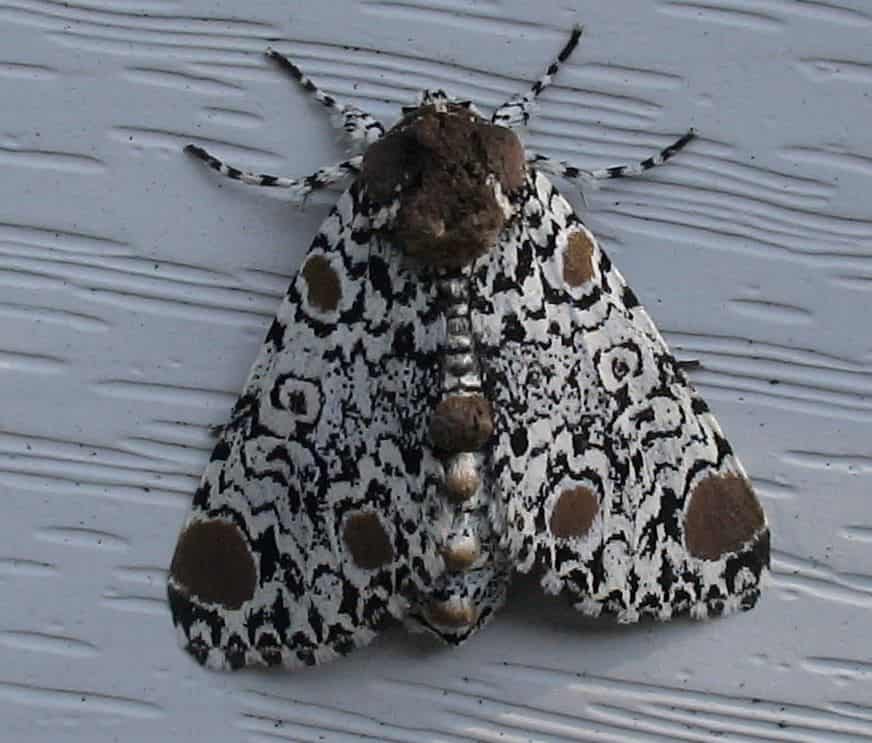
True to their name, Harris’ three spot moths have three large spots, as well as several smaller spots.
©Mothman27, CC BY-SA 4.0, via Wikimedia Commons – License
White-Spotted Sable
Location: Europe, Asia (Siberia), and North America (U.S. and Canada)
The white-spotted Sable species have black bodies with large white spots. They are most often found in fields during the daytime. These moths fly in a spinning pattern that can be hard to follow. They have a wingspan of ¾ to 1 inch.
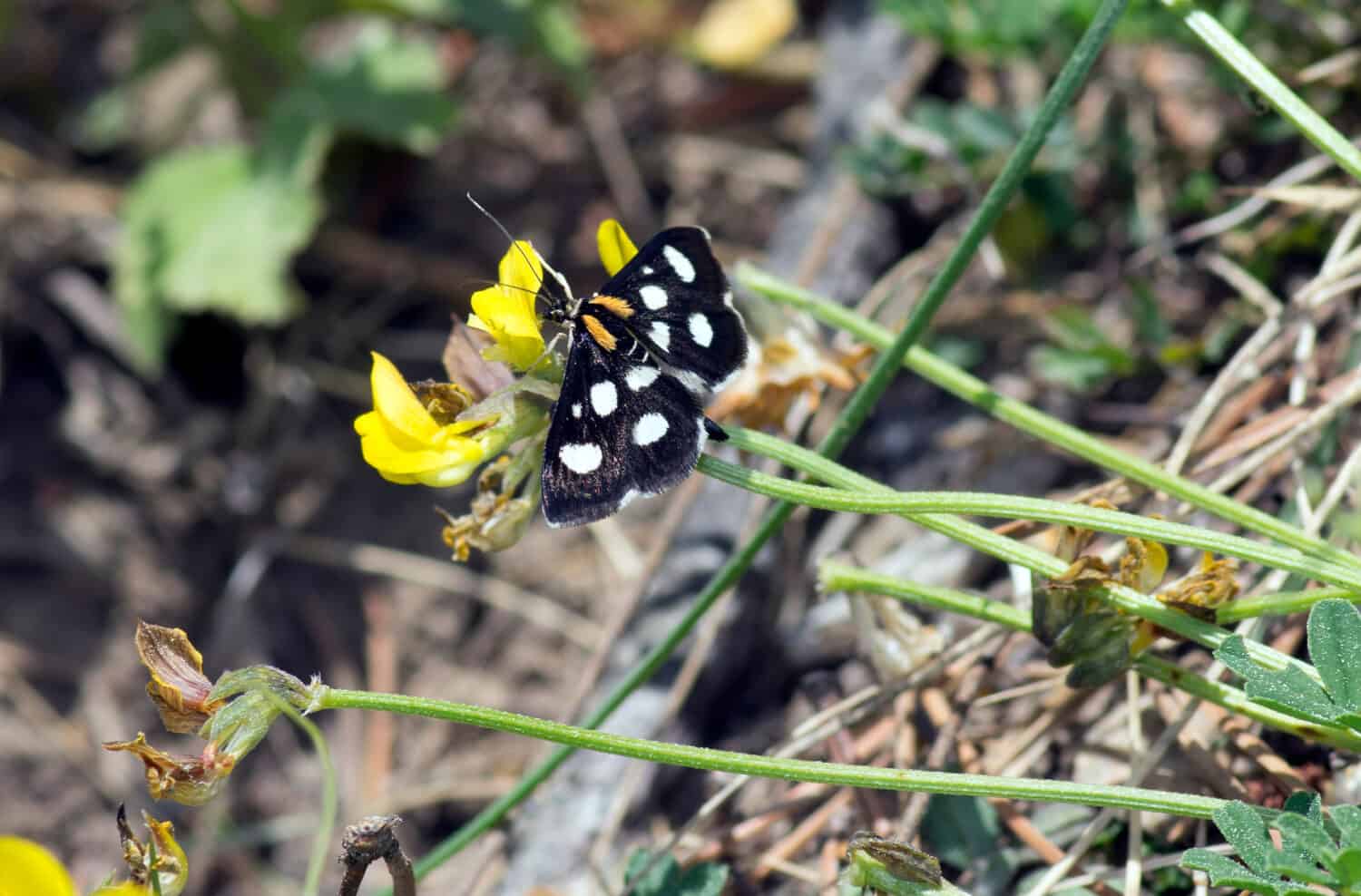
White-spotted Sable moths have black bodies and large white spots.
©A.S.Floro/Shutterstock.com
Spotted Peppergrass
Location: North America (U.S. and Canada)
The spotted peppergrass moths are mainly white with small black symmetrical splotches on their bodies. They get their name from the plants which are hosts to their larvae — spotted peppergrass plants. They have a wingspan of around ⅗ inch.
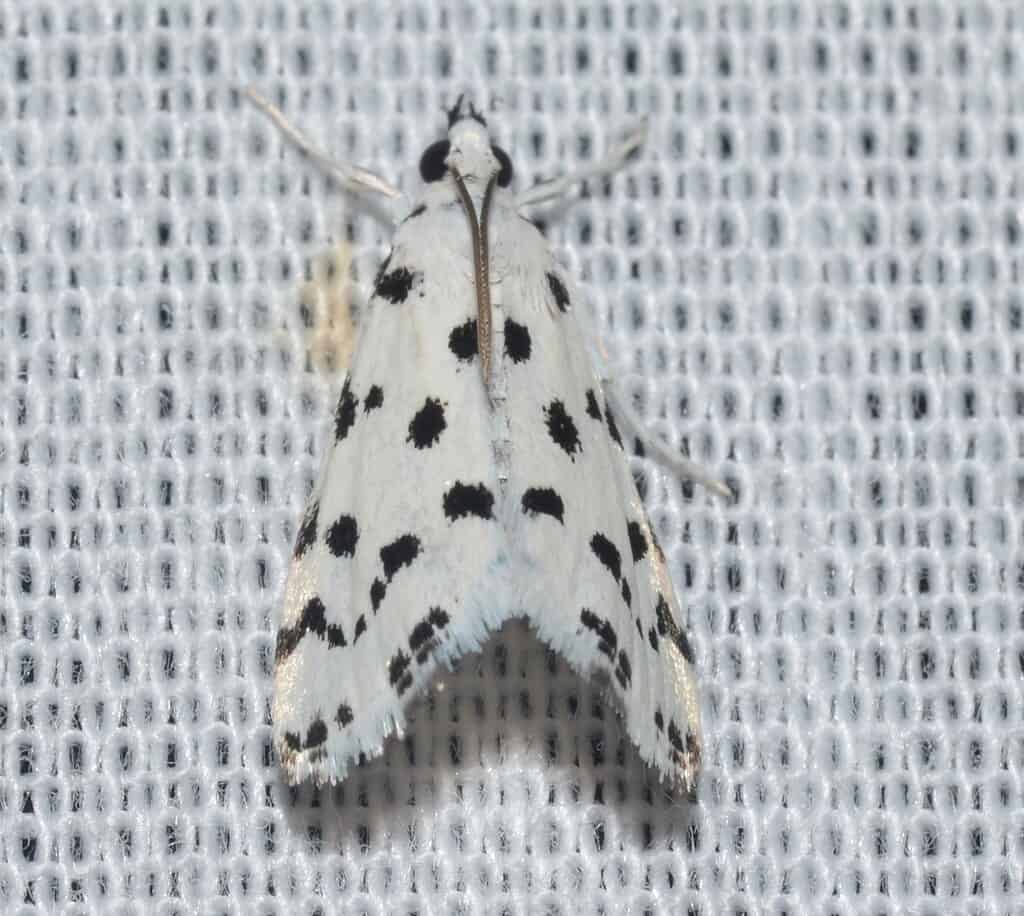
Spotted peppergrass moths have tiny black spots all over their bodies.
©Andy Reago & Chrissy McClarren/Wikimedia Commons – License
White Stripe-Backed
Location: North America (U.S. and Canada)
White stripe-backed moths are white or cream, with a black arrow-shaped line running across their backs. Their forewings are a length of less than ¼ inch.
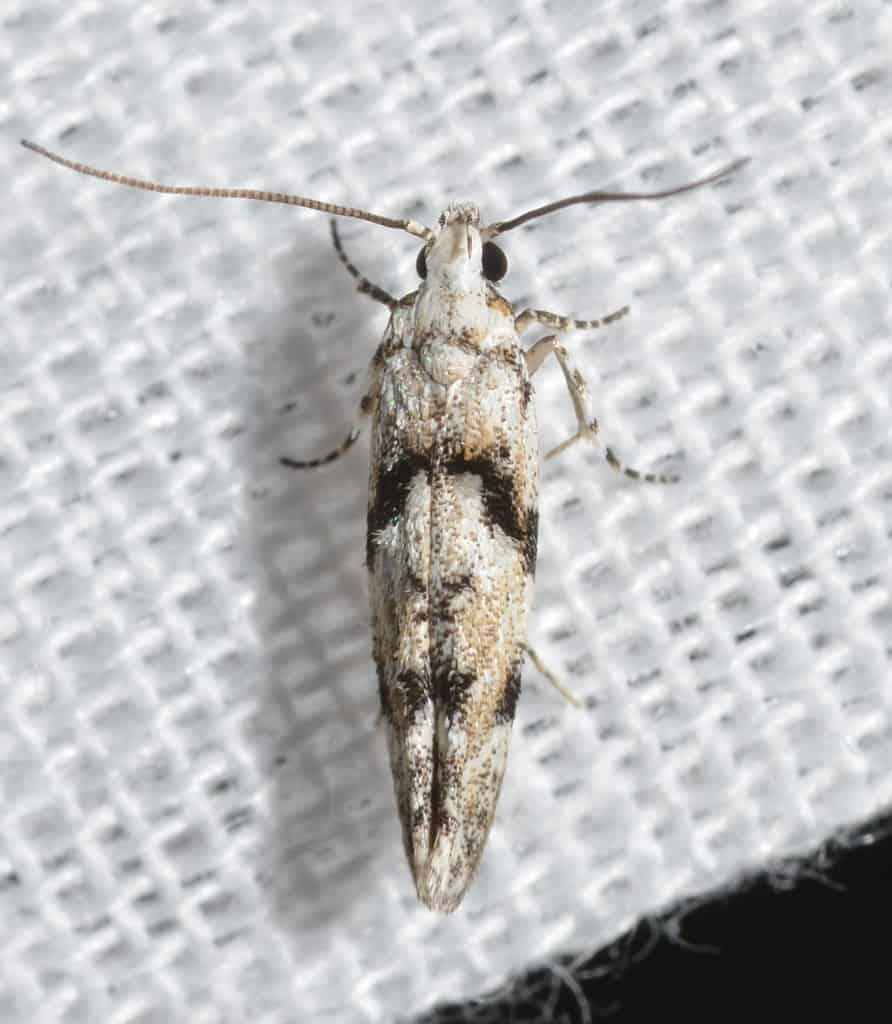
With forewings shorter than a quarter of an inch, white stripe-backed moths are particularly small.
©Andy Reago & Chrissy McClarren/Wikimedia Commons – License
Schlaeger’s Fruitworm
Location: North America (U.S. and Canada)
These moths are white with gray, black, and brown markings. As adults, they closely resemble a bird dropping when resting with closed wings. They have an average wingspan of 1 inch.
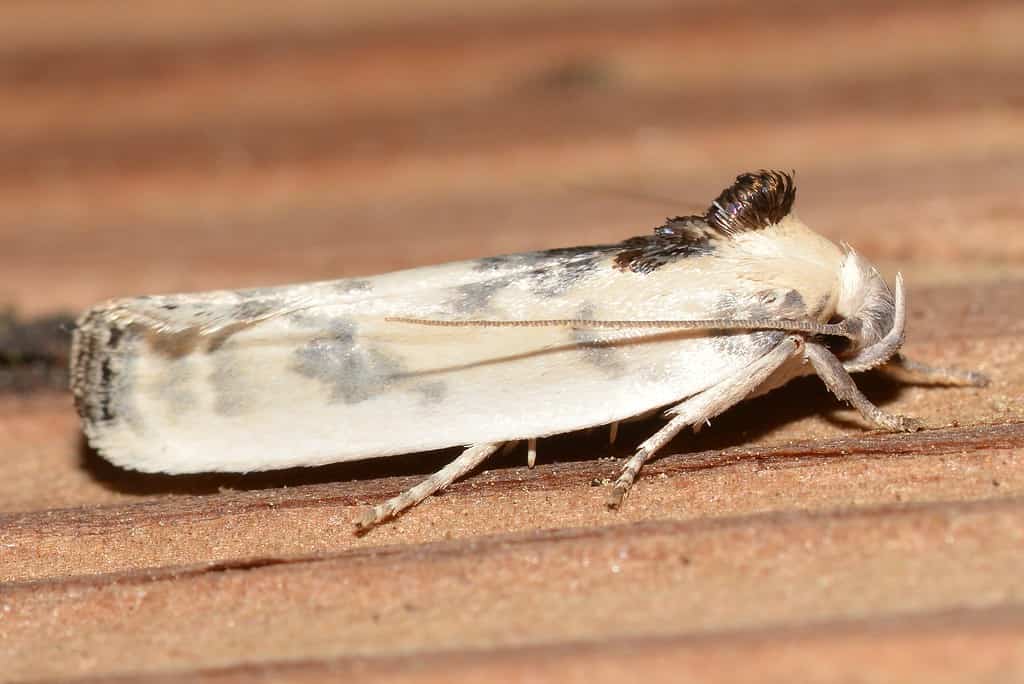
Schlaeger’s fruitworm moths resemble bird droppings when at rest.
©Andy Reago & Chrissy McClarren, CC BY 2.0, via Wikimedia Commons – License
Confused Meganola
Location: North America (U.S. and Canada), Europe, Asia (India), South America (Colombia)
Confused meganola moths are white with an intricate flowing pattern of small dark brown or black spots. They have an average wingspan of ⅝ to 1 inch.
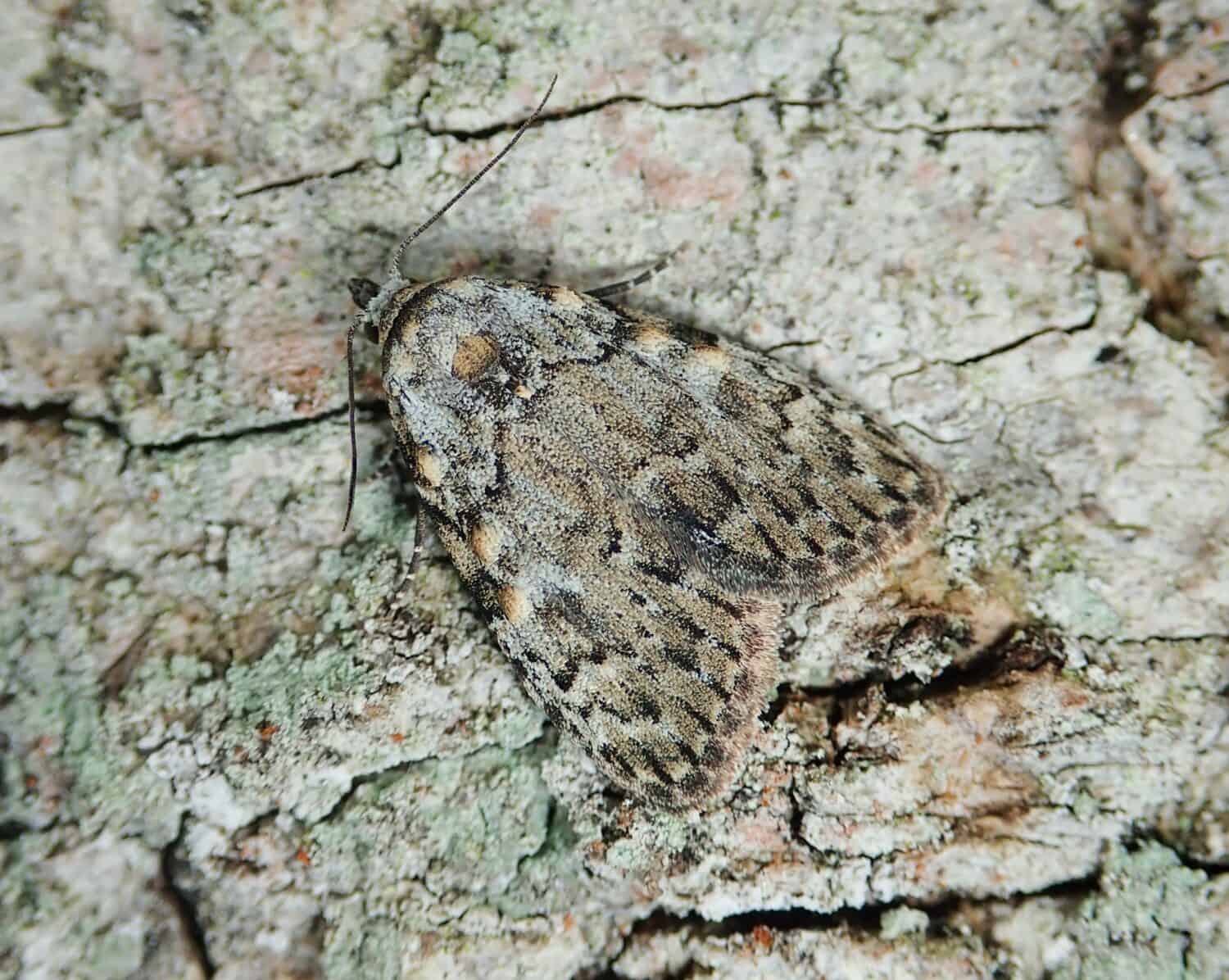
With a wingspan of up to an inch, confused meganolas aren’t small, but they’re not the biggest moths, either.
©DJTaylor/Shutterstock.com
Zebra Conchylodes
Location: North America (U.S. and Mexico) and Central America
These moths are resemblant of their name, featuring white bodies with six black stripes. They also have a small orange section on the bottom parts of their bodies. Their average wingspan is 1 inch.
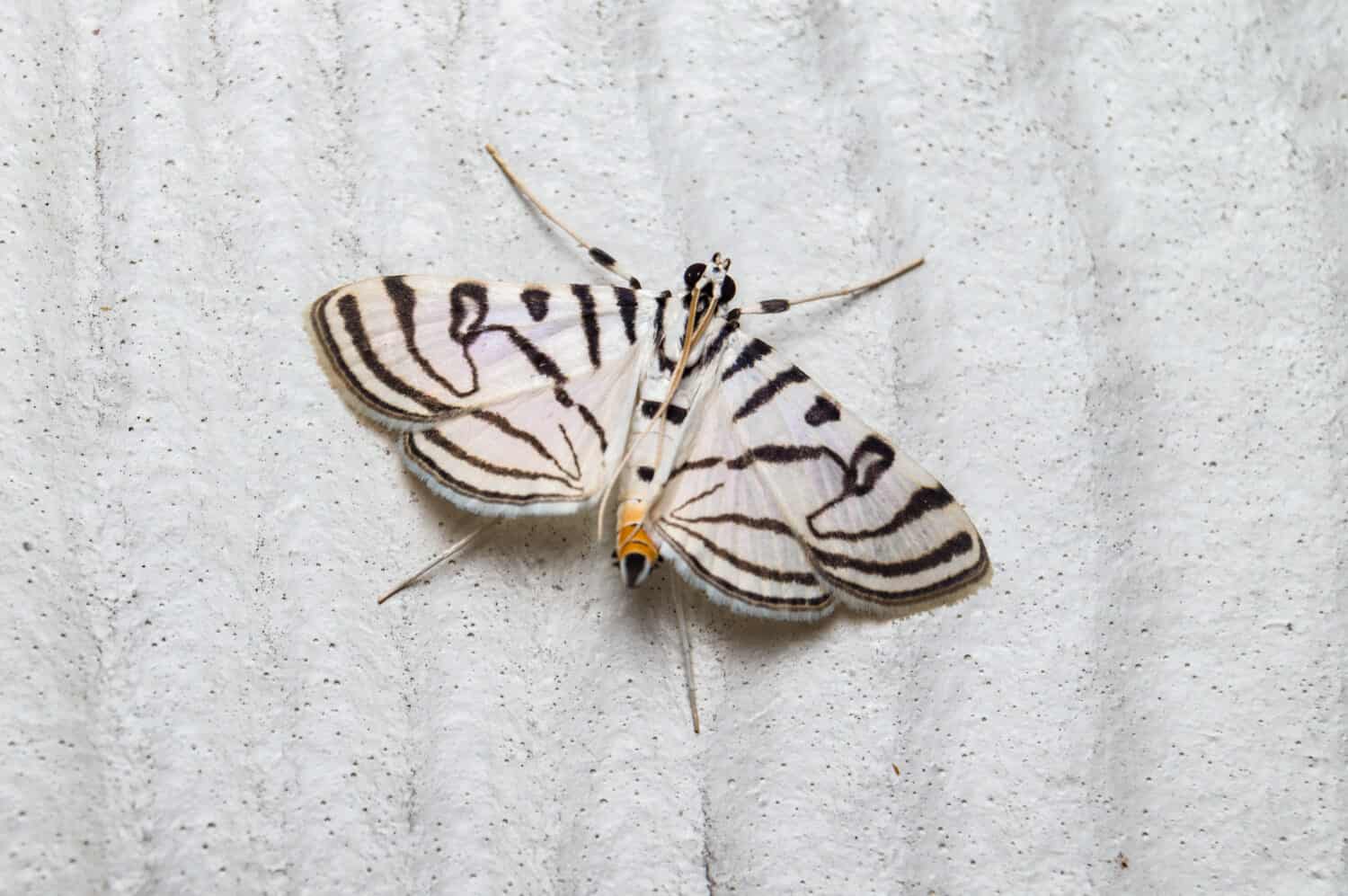
Zebra conchylodes have white bodies with six black stripes.
©RousePhotography/Shutterstock.com
White-Tipped Black
Location: North America (Eastern U.S. and Mexico) and Central America
White-tipped black moths are true to their names, with black bodies and wings with a small white tip. The upper portions of their bodies are red-orange. These moths have a wingspan of 1¼ inches.
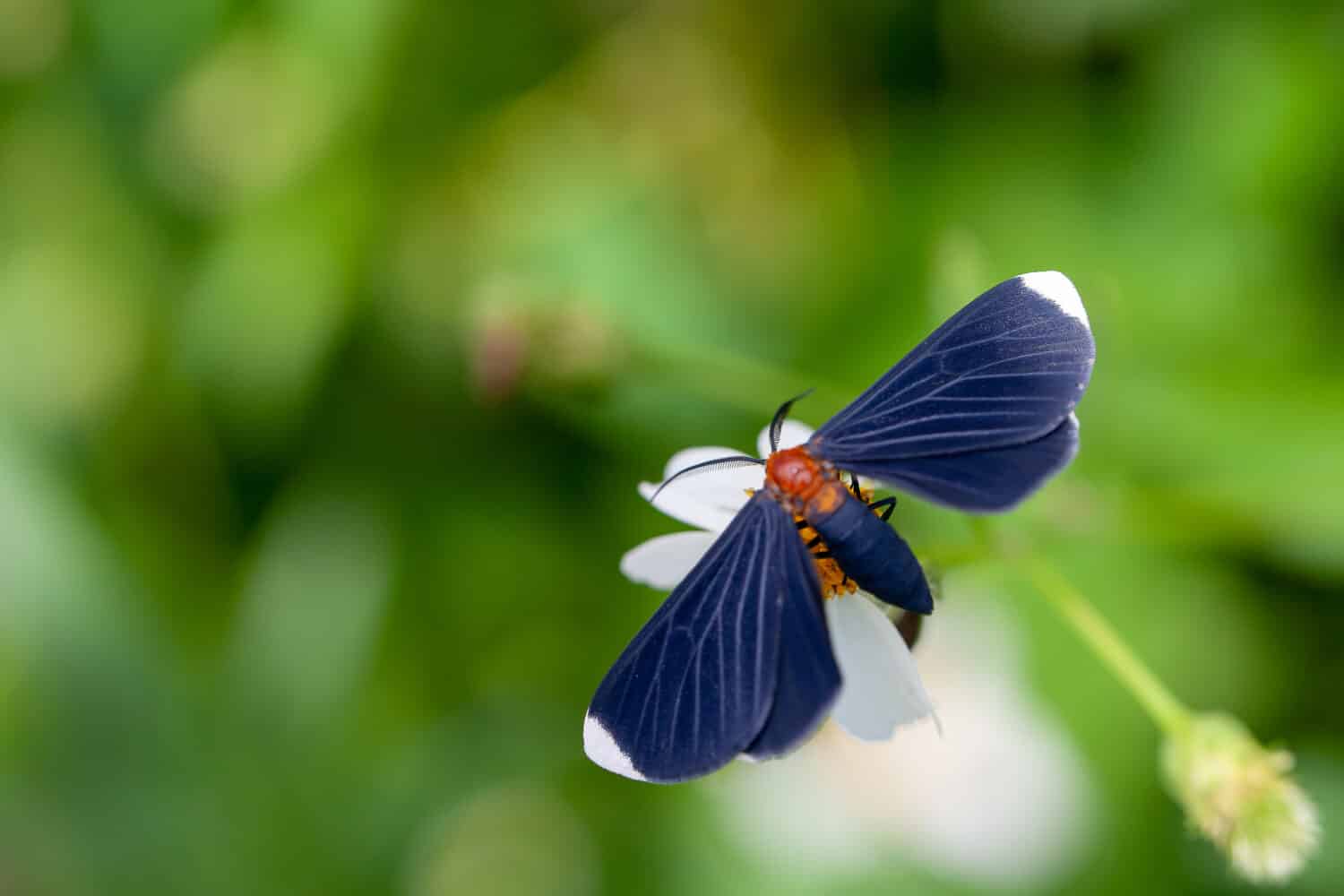
White-tipped black moth resting on greenery.
©pixelworlds/Shutterstock.com
Police Car
Location: North America (Western U.S, and Western Canada)
Police car moths have similar markings to a butterfly. Their wings have a black outline with a few white patches inside, broken apart by black veins. Their average wingspan is a little over 2 inches.
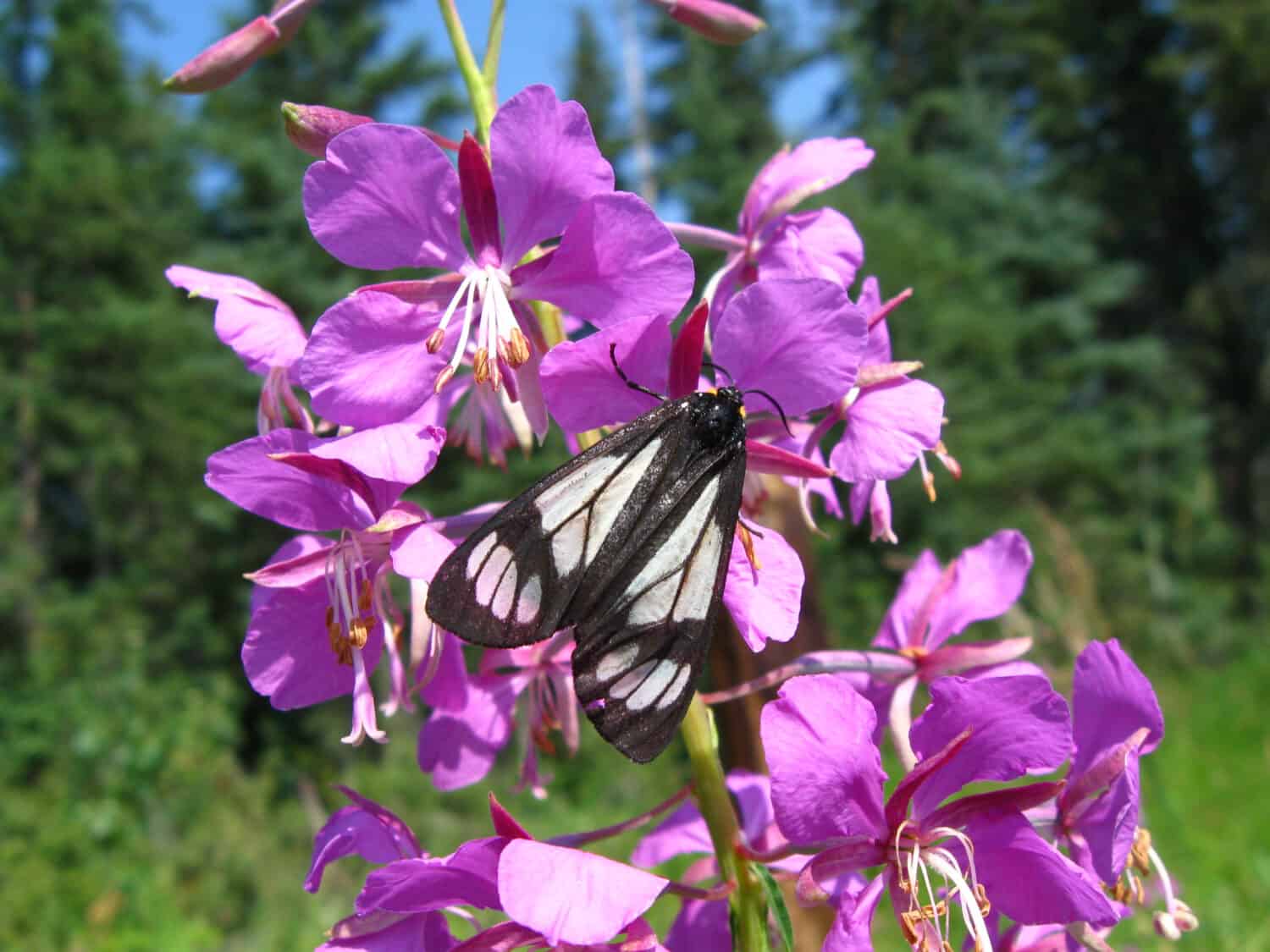
Police car moth resting on a purple flower.
©Tiffany K/Shutterstock.com
Dot-Lined White
Location: North America (Southeast U.S.)
The dot-lined white moth species are white insects with small black speckles that line their backs in rows. They are nocturnal moths that have an attraction to light. Their wingspan size varies greatly from 1 to 2½ inches.
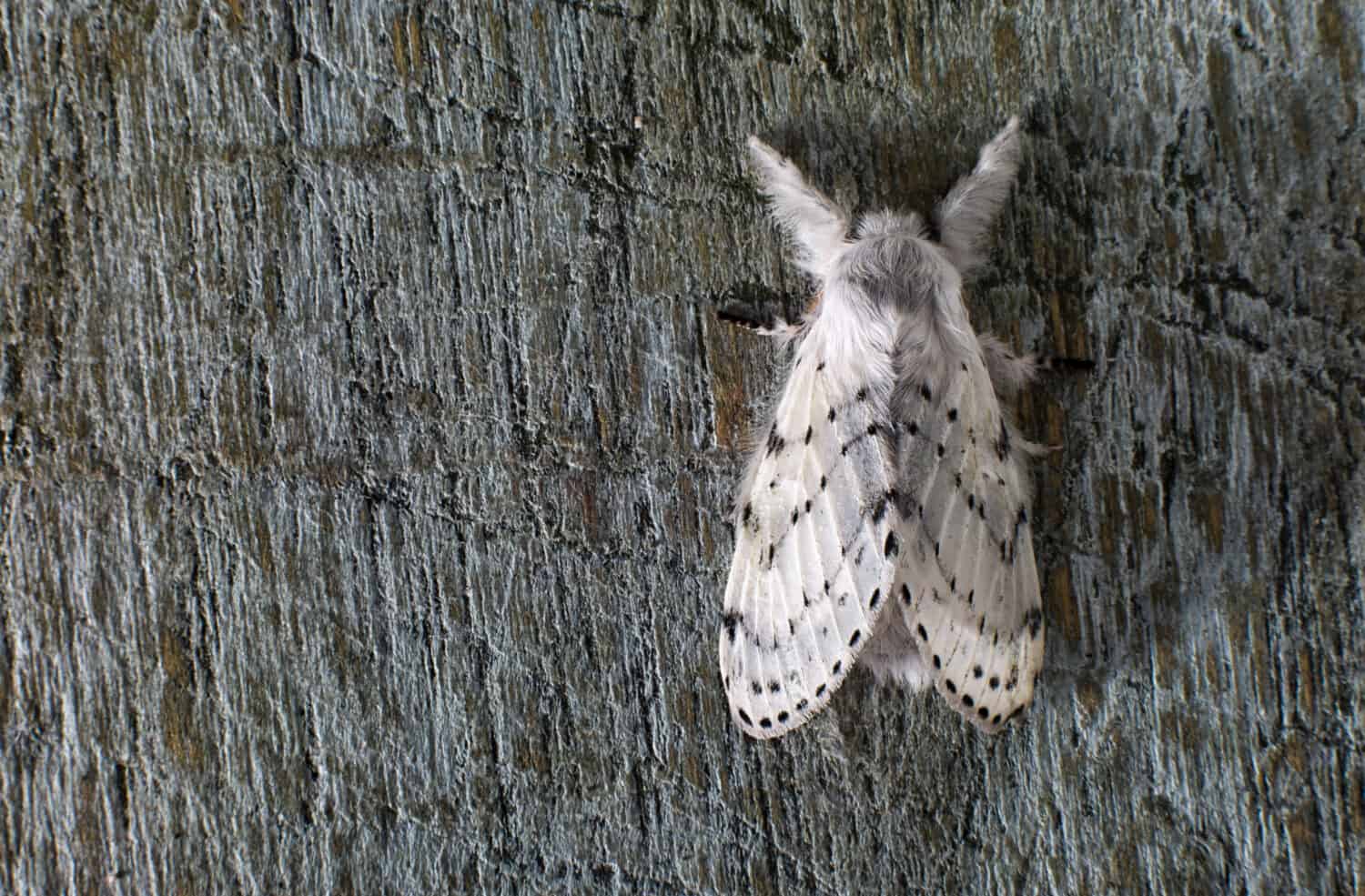
Dot-lined white moths have white bodies with lines of small black dots.
©Barna Tanko/Shutterstock.com
American Oak Beauty
Location: North America
American oak beauty moths are found all across North America, from Alberta, CA, to southern parts of Mexico. Their coloring closely resembles the bark of oak trees, and they use that as camouflage. They have a wingspan of 1½ to 2 inches.
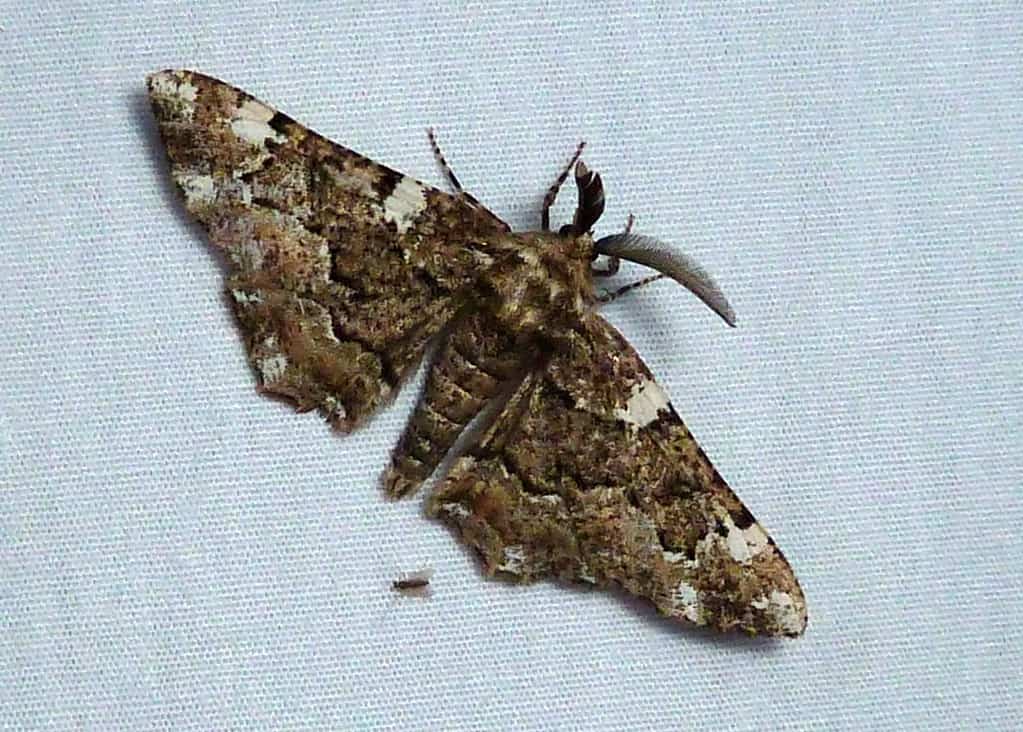
Oak beauty moths live throughout several parts of North America.
©Cyndy Sims Parr/Wikimedia Commons – License
Laugher Moth
Location: North America
Laugher moths are white with intricate black or gray swirls across their entire bodies, excluding their hindwings. They got the nickname ‘laugher’ because their closed wings resemble a man laughing. They have a wingspan of 1½ to 1¾ inches.
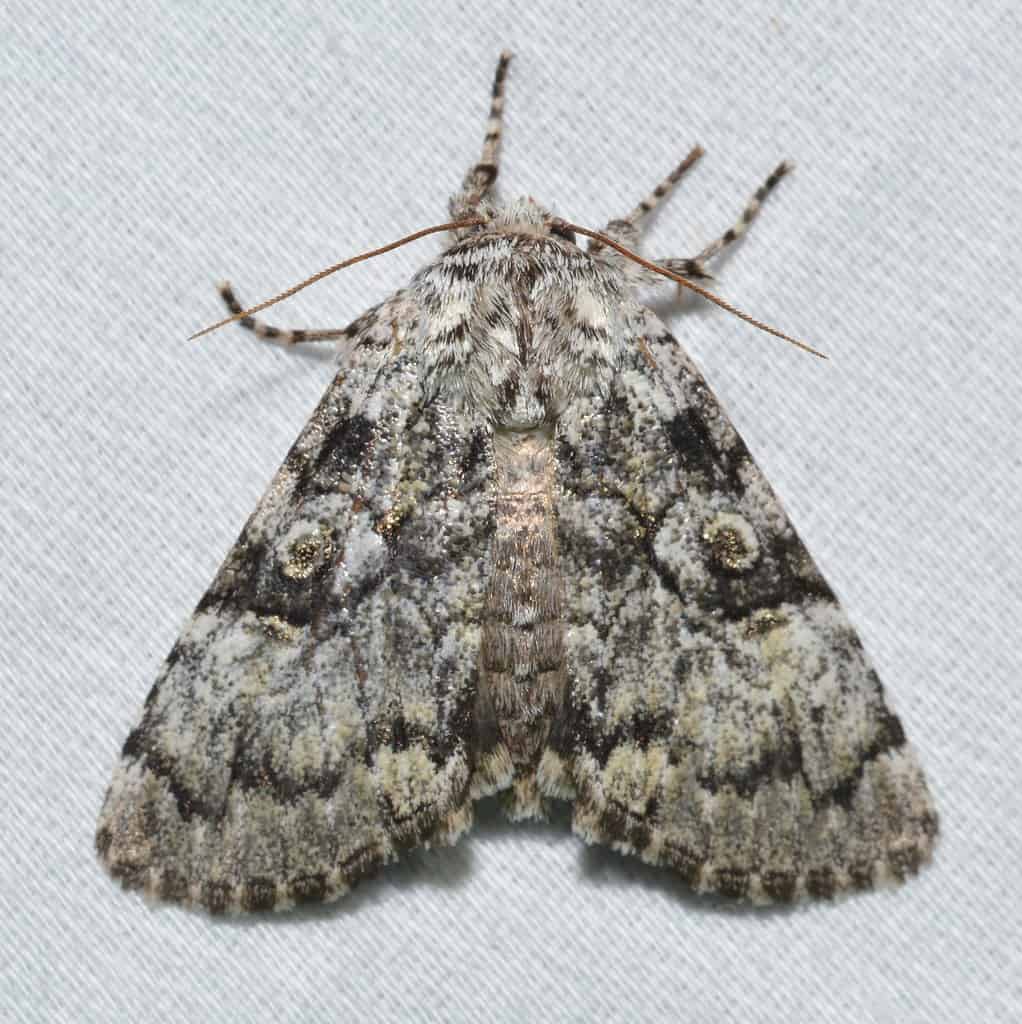
The laugher moth’s name comes from the appearance of its wings when closed.
©Andy Reago & Chrissy McClarren/Wikimedia Commons – License
Little White Lichen
Location: North America
Little white lichen moths are white with gray or black wavy stripes that go across their backs. They are named after lichen, which is the host and food source for their larvae. They have a wingspan of ½ to 1 inch.
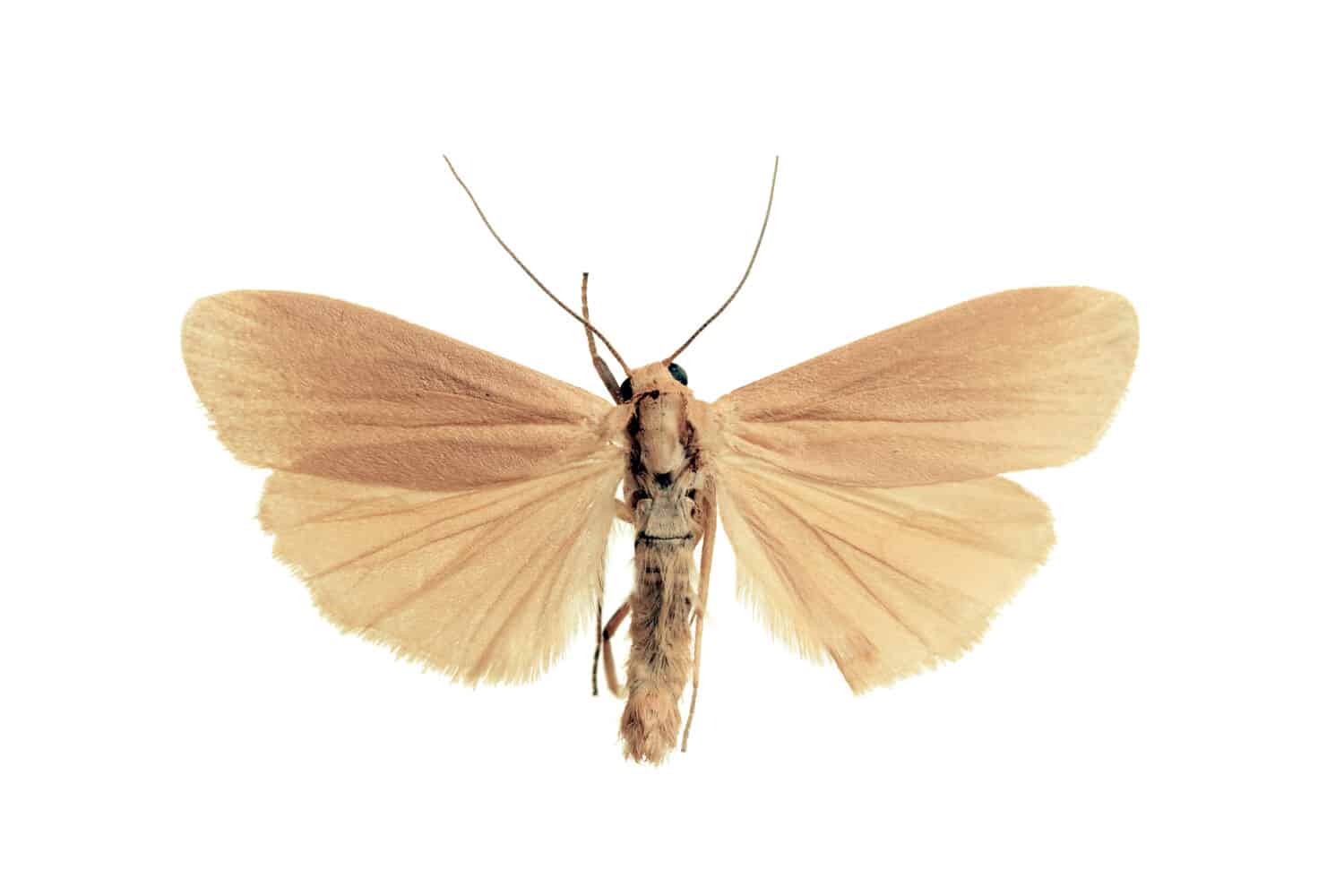
Little white lichen moths are mostly white, with black or gray stripes along their backs.
©Peter Waters/Shutterstock.com
White-Striped Black
Location: North America (U.S. and Canada)
True to their name, white-striped black moths have black bodies and wings, with one or more wide white stripes running across vertically. The edges of their wings usually have a white tip as well. They have an average wingspan of ¾ to 1 inch.
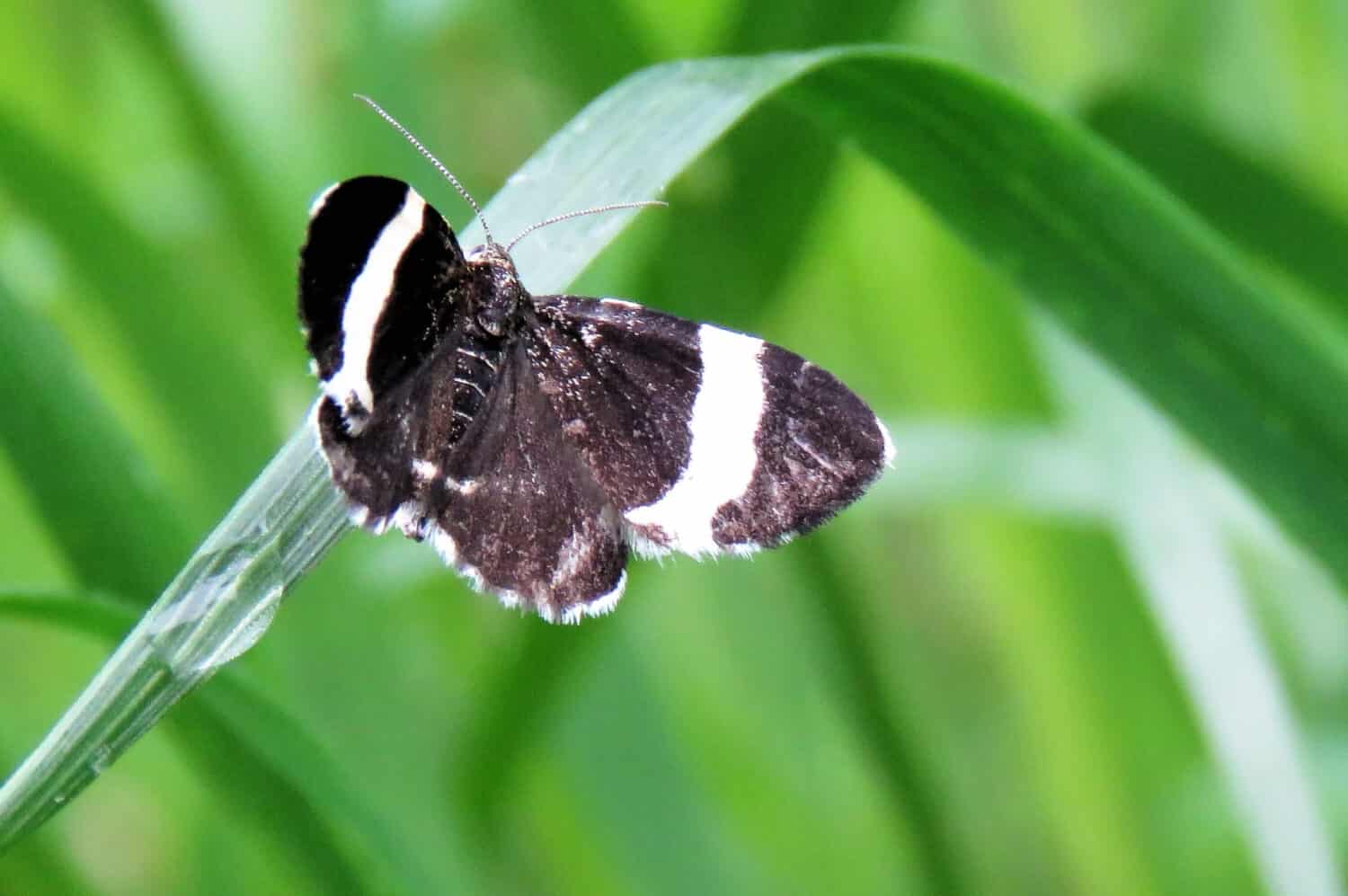
White-striped black moth resting on a blade of grass.
©Jeremy Ferrari/Shutterstock.com
Buck Moth
Location: North America (U.S.)
Buck moths are similar in color to the white-striped black moth and can often be confused. They have all-black bodies with a wide white stripe that runs across their wings. They’re certainly one species not to mess with, as their larvae are covered with hollow spines that are poisonous. Touching one causes pain similar to a bee sting, which may last a day or more. Adult buck moths have a wingspan of 2 to 3 inches.
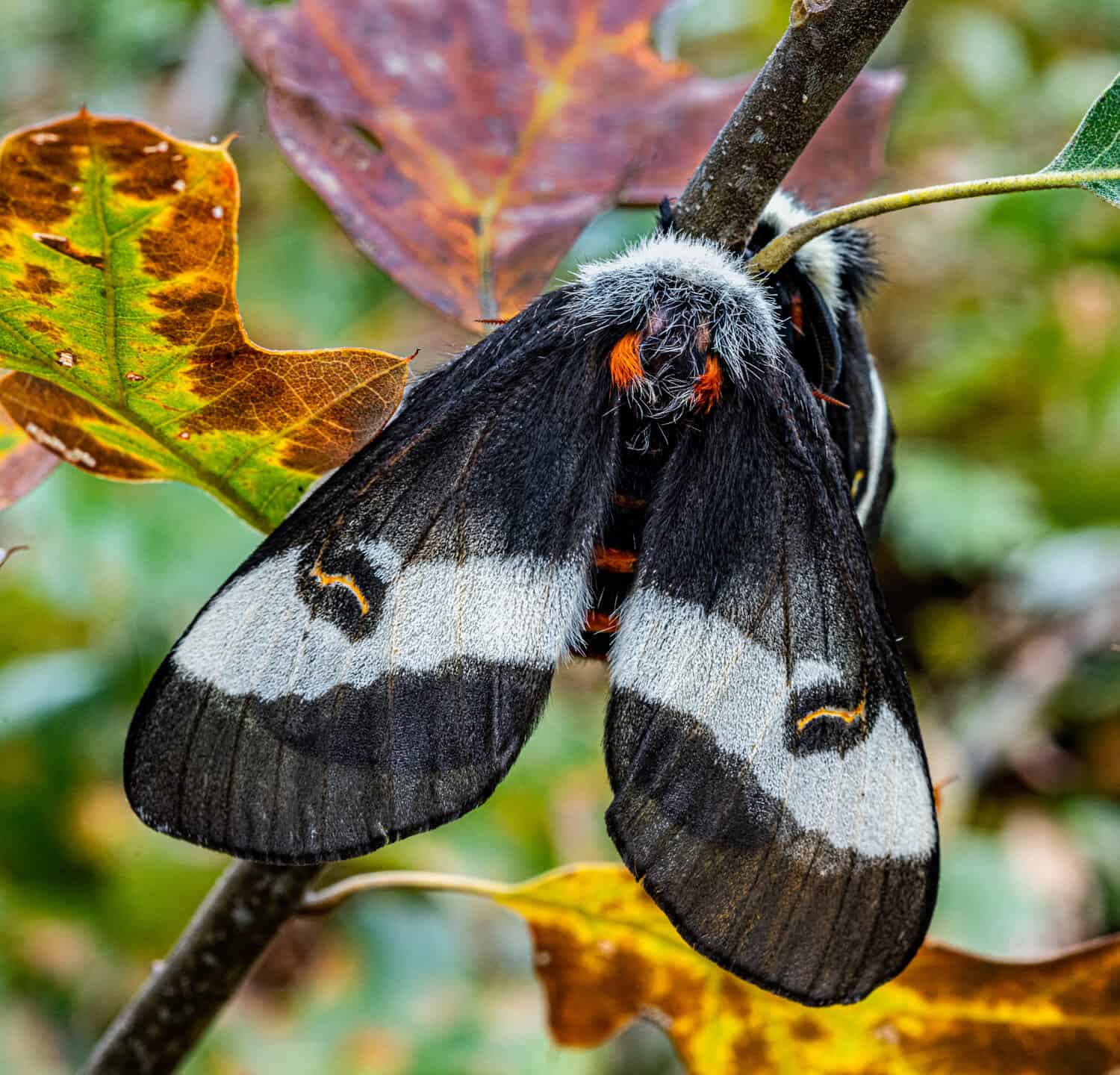
A buck moth resting on a branch.
©Alan B. Schroeder/Shutterstock.com
Leconte’s Haploa
Location: North America (U.S. and Canada)
These moths are mainly white with a black or dark brown line running down their back, ending in a semi-circle shape. The edges of their wings are also black or dark brown. They have a wingspan of 1½ to 2 inches.
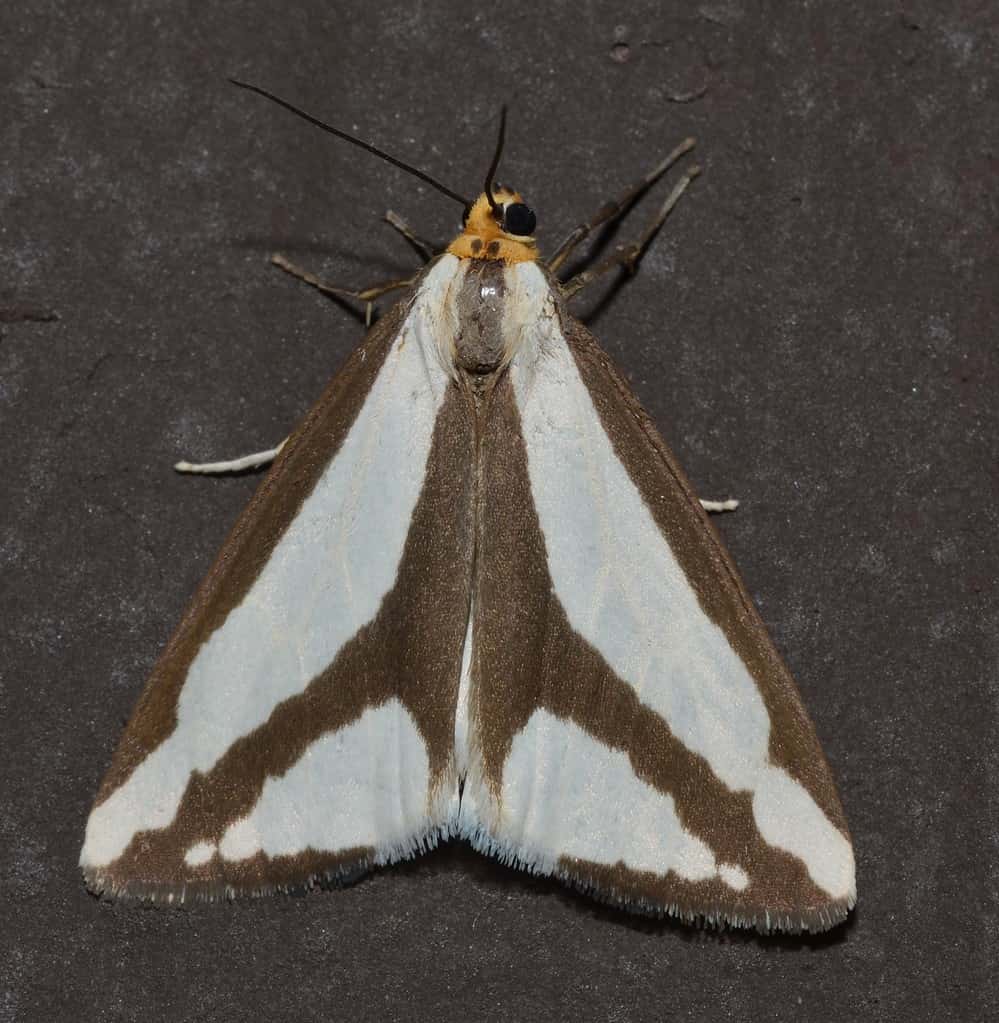
Leconte’s haploa moths have a striking black stripe along their wings.
©Andy Reago & Chrissy McClarren/Wikimedia Commons – License
Carpenterworm Moth
Location: North America (U.S.)
Carpenterworm moths are white, black, and gray with small circular patterns. Male carpenterworm moths have orange on their hindwings. Their larvae are a common pest that will infest deciduous and fruit trees, causing them to lose limbs or die. They have a wingspan of 1½ to 3½ inches.
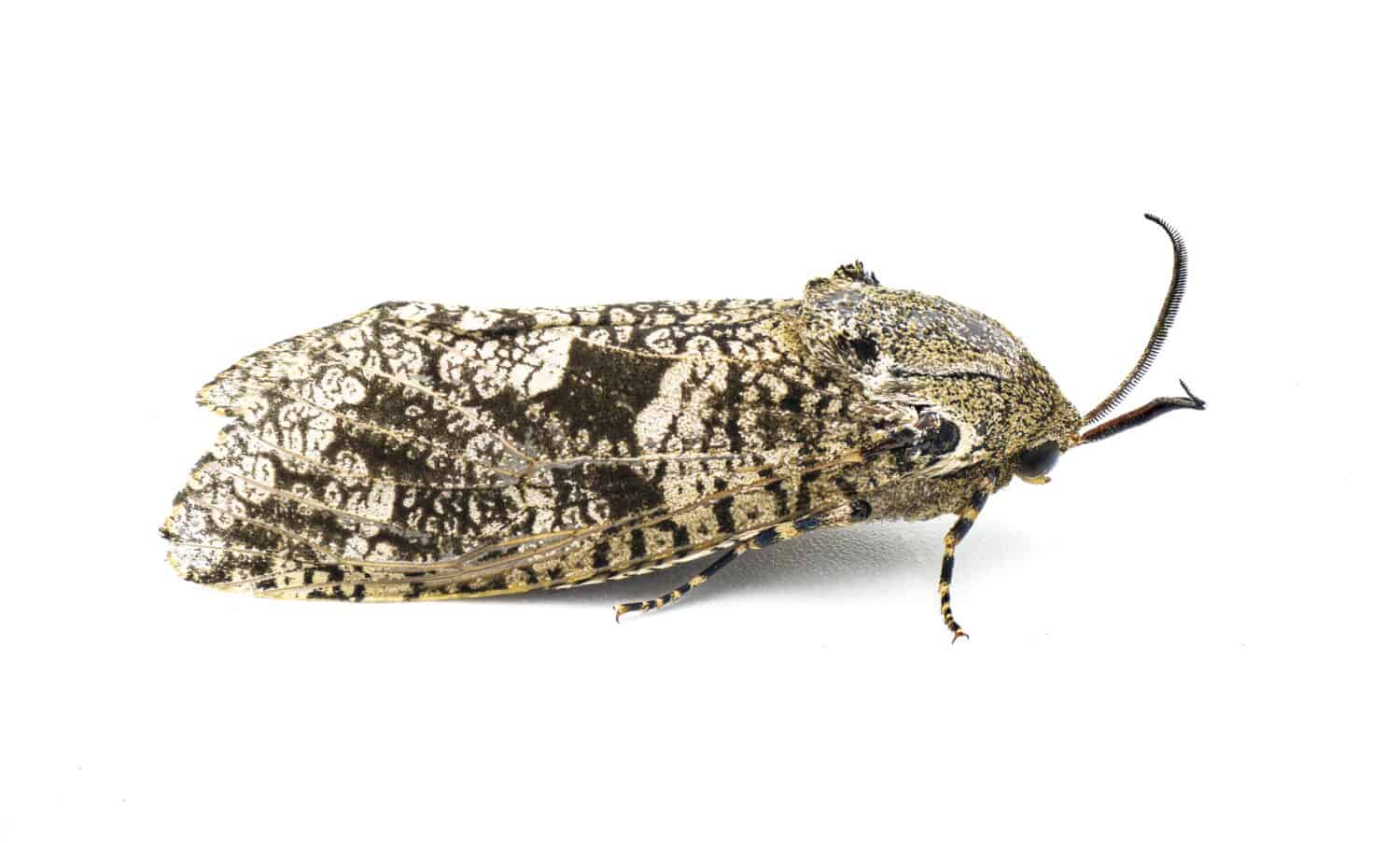
The carpenterworm moth has small grey and black circular markings on a white body.
©Chase D’animulls/Shutterstock.com
Hebrew Moth
Location: North America (U.S. and Canada)
Hebrew moths are white with squiggly black line patterns across their backs. Their name comes from the similarity of their patterns to Hebrew characters. They have a wingspan of 1 to 1½ inches.

Black squiggly lines across a white body and wings characterize the Hebrew moth.
©Andy Reago & Chrissy McClarren/Wikimedia Commons – License
Bonus: Black and White Moths

The Peppered moth has tiny black spots on its wings, hence, the name Peppered Moth.
©Marek R. Swadzba/Shutterstock.com
Here are some black and white colored moths that didn’t make the list:
- Peppered moth
- Cream-spot tiger moth
- Greater Death’s head hawkmoth
The peppered moth’s color change during the Industrial Revolution, known as industrial melanism, saw dark-colored moths becoming more common due to pollution. Scientists breeding the moths found that the black color in the dark form resulted from a mutation in the DNA of the light-colored moths, highlighting an evolutionary shift driven by environmental factors.
While the cream-spot tiger moth isn’t solely black and white, the contrasts of the black and white color on their wings make them a stunning bonus moth! When threatened or disturbed, this creature also unfurls its yellow hindwings and reveals an orange/red abdomen as a warning signal to deter potential predators.
Acherontia lachesis also known as the greater death’s head hawkmoth or bee robber, is a sizeable sphingid moth, boasting wingspans of up to 13 cm. It is native to India, Sri Lanka, and various parts of the Oriental region. This moth belongs to the Acherontia genus, which includes three species of death-head hawkmoths.
Strikingly similar to a bee, its yellow or pale colors put it on this bonus list!
Are There Black and White Butterflies?
Both butterflies and moths come from the same family–Lepidoptera. As you’ve enjoyed the beauty of these stunning black and white moths, you may now be wondering if there are any butterflies with the same colorings. The fact is, yes, there are many varieties of gorgeous black and white butterflies. Let’s take a look at a few.
Chiricahua White
The Chiricahua white, also known as the Mexican white pine butterfly, inhabits the U.S. southwest and Mexico. Its open wings are white with black wing veins, and there are black edges on its forewings. Only the males of this species are black and white–the females are black and orange. Their wingspan varies from 1.75 to 2.25 inches.
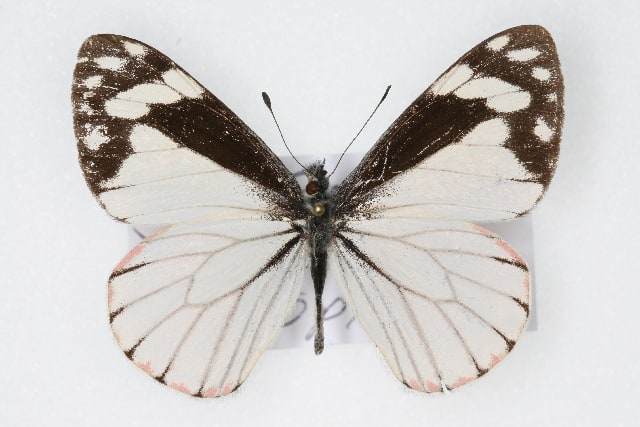
The Chiricahua white, also known as the Mexican white pine butterfly is found throughout Mexico and some southwest U.S. states.
©Unspecified, Colorado State University / CC BY 3.0 – License
Desert Marble
The wings of the desert marble appear as if they have been sprinkled with powdered sugar in the darker areas around the tips, with the inner areas being milky white. Their wingspan is around 1.5 inches. You can find this species in the western portion of the U.S. and northern Mexico.

Desert marble butterfly resting on greenery.
©Charles J. Sharp / CC BY-SA 4.0 – License
Common Sailor
Focusing more on the coloring of white on black, the common sailor butterfly’s wings are black with delicate white stripes running across their wings, which average 2 inches in wingspan. These beauties are native to India and parts of Southeast Asia.
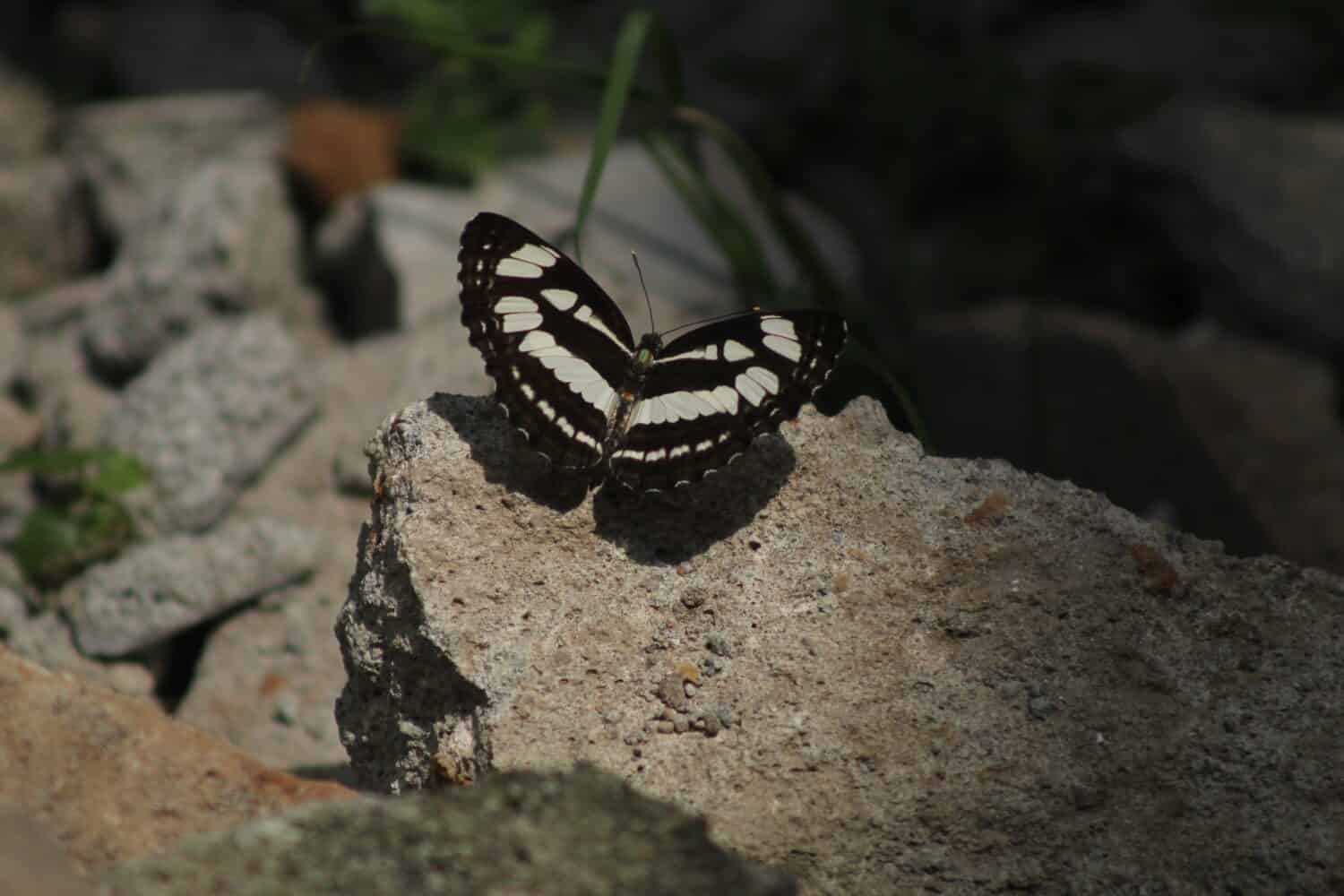
Common sailors live across India and Southeast Asia.
©BegawanStudio/Shutterstock.com
Other black and white butterfly species include:
- Cabbage White
- Marbled White
- White Admiral
- Zebra Longwing
- Zebra Swallowtail
- Pale Swallowtail
- White Morpho
The photo featured at the top of this post is © Andy Reago & Chrissy McClarren, CC BY 2.0, via Wikimedia Commons – License / Original
Thank you for reading! Have some feedback for us? Contact the AZ Animals editorial team.



